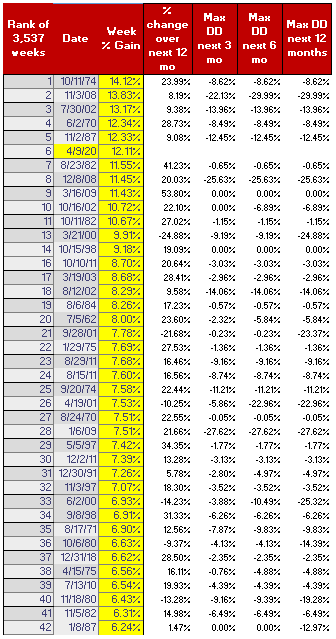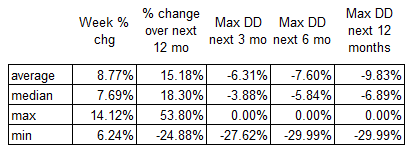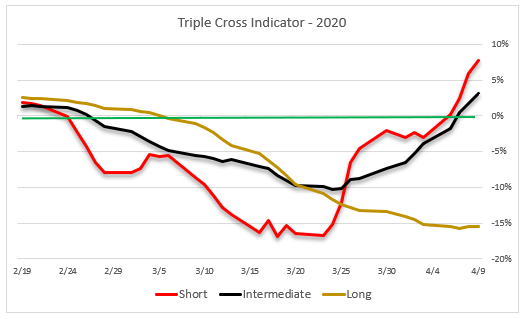A 25% rally off the bottom can't be ignored, but is it time to buy yet?
In this article I'll examine the historical record of bear market bottoms going back to 1950. Specifically, I'll look at the biggest 1-week market rallies and try to draw some conclusions about what's likely to come next for the market.
Setting the table
For the week that ended on April 9, 2020, we saw a monster rally in the S&P 500 - up 12.1%. It capped a 25% rally off the low, which was set on March 23rd. Can this rally be sustained? Or is it just a classic bull trap?
I've had a number of inquiries lately from clients who are asking if it's time to get back into the market. I don't have a definitive answer, but I do have history as a guide.
I looked at the biggest 1-week gains for the market since 1950 and calculated what happened after 3, 6, 9, and 12 months. The table below shows the results.
There's a lot to unpack here, so let's start with the easy stuff. There have been 42 big up weeks since 1950. What's a big up week? A week that is a 3-Sigma event, meaning that it's 3 standard deviations above the normal range.
What has happened after these big weekly gains in the past? There's good and bad news.
On average, the market is higher by roughly 16.5% 12 months later. You could stop there and say "that's good enough for me." But the bad news is that the market has also been lower by 25% 12 months later. That happened after the big up week in March 2000.
There are several other examples from the table that show significant losses after big up weeks, so the lesson is to tread lightly.
Introducing the Triple Cross Indicator
In my quest to find the bottom of this bear market as well as all others, I came up with a handy tool. I queried my historical database and asked it to show me three moving average crossovers - short, intermediate, and long term.
My statistical software obliged and presented the chart below. After backtesting, I determined that the safest time to re-enter the market is when all three moving average crossovers cross above the green line from below.
As of today, April 9, 2020, two lines are above and one line is below. When all three lines are above the green line, a bull market is assured with 87% confidence, using Bayesian probability.
Some very smart people have asked me the following: "Aren't you giving up much of the gains while you are waiting for the long (brown) line to catch up to the red and black lines?" To which I answer, yes. But what I gain by waiting is avoiding the painful and dispiriting whipsaws that accompany impatient investors who don't want to wait for confirmation.
Final thoughts
This article is based on history, but history can only take us so far. I also have experience and judgement, and I don't think we've seen the bottom of this bear market yet.
It's reasonable to start nibbling on the long side as long as you don't go all-in. Save some ammo for the inevitable dips that are sure to follow as we get economic and earnings reports in the weeks and months ahead.




As I have commented many times. History is no good this time. Why? 2 trillion from fiscal policy and more coming. 2-3 trillion from monetary policy (Fed) and more. Fed even buying corporate bonds.
My many corporate bonds took pretty big jumps last week when fed said buying corporate even some not investment grade. THIS NEVER HAPPENED BEFORE THIS TIME IS DIFFERENT!!!
There may be a few dips from here but will not last long. Have to buy quick.
Don’t fight the fed and now monetary policy. Don’t listen to news. Just buy the dips
6 and 12 months from now you will be very happy
Howard Randall
Hello Erik,
Thanks for an excellent and timely article!
I’ve been in cash since January, waiting for the bottom to buy back in. A friend and financial advisor encouraged me last week to put 80-90% of my money back to work, he is telling all his clients to do the same.
I stated my concerns that earning reports would be coming out soon, that I didn’t think the whole extent of the damage was known, and that we hadn’t seen the bottom yet.
He argued that nothing had been fundamentally wrong with the economy before the coronavirus, and due to the massive (and highly inflationary) Federal stimulus, stocks were the only place to hide. The Dow @ 21,500-22,000 was low enough to buy in, and regardless of whether stocks did go lower (now we’re @ 24,000!) I would be very happy with the results long term. He pushed me hard saying that, the recovery would be very quick and I wouldn’t want to miss it.
Erik, I read a lot of independent opinions in addition to yours, and so far it seems like the winners at calling the bottom so far have been the “don’t fight the Fed” and “it’s already priced in” crowd, who base their decision on technical analysis of the market. I know Jack Bogle’s words “nobody knows nothing” and “don’t do something, just stand there”, but it’s painful watching this apparent opportunity go away.
Because most are forecasting muted equity returns in the next decade (you have an excellent article titled “Expected Equity Market Returns”!) it seems like this may be one of the last good times to “make hay”.
disclaimer: I tend to see things as more urgent and dramatic as they generally turn out to be, so take what I write FWIW.
I still don’t know what I will do on Monday, but I want to find a way to get back into the market while still protecting the downside (S&P 500 index fund or carefully selected stocks, watching earnings announcement dates, setting stop limit orders, etc.).
Thanks very much!
Duane
Just as a follow-up, the main question from my side would be “If I’m really going to do this, and jump into the market on Monday, what is the best way to protect the downside?”.
Do I just watch the indicators and pull out at the first sign of trouble, or do I set stop limit orders on ETF’s / stocks, or how can I keep from getting too hurt if I insist on doing this potentially risky thing?
And what is the worst that can happen if I wait? Will the stock market fully recover without me and I will be scraping together 2-3% real returns for the next 10 years just for an OK retirement or is there still lots of upside to be had?
The reality is that I’m fortunate and don’t need to make that much to have an acceptable retirement, but there is a big difference in quality of life between say 2-3% real and 6-8% real, and with so many unknowns in the future (inflation, taxes), I really want to shoot for the higher number.
I hope that one day in retrospect I will read this again and realize that everything turned out fine, and maybe even chuckle, but at the moment I’m just not so sure.
Thanks!
Duane
Thanks Erik!
I am not a fan of historic performance, but I like history a lot. Numbers means nothing. Mode and economic conditions means a lot. Market is equal opportunity dream destroyer. Market is wealth transferring mechanism. Market is build to make the most pain to the participants. Without maximum pain market can’t find the bottom. Traded and invested over 30 years and this time did not see panic YET !!!!!!! I saw orderly liquidation in positions , was no panic in options market. Market makers did not loose their minds. In 2018 December 24 th was bigger panic in options market. People do not agree with me and I do not care. Market went down 34% , it’s time to buy. NO. Market just stabilized after decline. Market has to go up, down or sideways. It has to move all a time. It has to make the worst pain for longs and shorts.
Now info for idiots :
1. VIX above 35 means no investments – only short term trades.
2. Too much money was lost picking bottoms and tops then made.
3. Investor can only make money in trending market and capitalize around 60% of the move.
4. FOMO is for traders , not for investors.
5. ON the bottom nobody wants to own anything at all.
6. To build bottom takes time . All traders have to be destroyed.( longs and shorts )
7. Technical analysis + understanding economics and cycles + understanding correlations + medical knowledge + intellectual curiosity + simple understanding about humans behavior will help you to find what YOU looking for.
8. There are bull and bear markets everyday somewhere !!!!! You just have to find them !!!!
Economics :
We will loose about 10 trillions . Fed and government giving about 6 to 8 trillions. We still short 2 trillions just to get even. How can we be in bull market ??????
Good luck everybody. Andy.